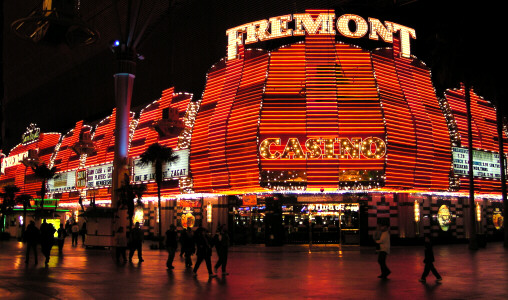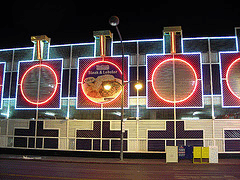
The Fremont Hotel was the first high-rise hotel to be built on Fremont Street. As the Riviera had done on the famed Las Vegas Strip, the Fremont was announcing that a new modern era was at hand.
For years, Las Vegans had considered Fremont Street filled with "sawdust joints". The Strip was for all those "carpet joints". But the times, as they say, were changing. Breaking with the familar western theme so prevalent downtown, owner Lou Lurie wanted a sleek, new, modern looking building.
Wayne McAllister, who had designed the El Rancho Vegas, had the original design of the Flamingo, the Sands and the Desert Inn as well, and his partner, William Wagner were hired to be the Fremont's architects. They, too, wanted to bring the Strip's amenities to Fremont Street. Soaring 13-stories above the main street in Las Vegas, the Fremont Hotel was, at the time, the tallest building in the State. According to Alan Hess, the tower "was faced with a multicolored curtain wall system of interlocking concrete panels and sunscreens. Pinks and browns were the integral colors." The tower was cantilevered, staggering the rooms so that no one would be located directly under another.
The signage for the hotel was designed by McAllister and fabricated by YESCO. McAllister articulated the signs as separate blades hung on the top and side of the tower. The style evoked California Modern.
The property had at one time been owned by the pioneering Von Tobel family who had been in Las Vegas since the Land Auction of 1905.
While Lurie owned the hotel, Ed Levinson, who had started out at the Sands Hotel, was the president of the Fremont Hotel Corporation, which was the parent company of the resort.
The Fremont opened on May 18, 1956 and invited the citizens of Las Vegas to the Opening Day party. It was also the opening of Helldorado Days, the annual Western event, so Hopalong Cassidy was the grand marshall and Lt. Governor (and former film star) Rex Bell, Sr was there as well. To celebrate the festivities, a pretty young girl sat atop a burro on the roof of the hotel to ensure that the Fremont was celebrating Helldorado too.
From the beginning, the Fremont became known for their food. Chef Schillig hailed from Europe and oversaw the daily food prepartion at the hotel. He had been associated with the Ritz Hotel in Paris and the Savoy Hotel in London as well as the personal chef of Prince Constantine of Greece before coming to Las Vegas.
Chef Billy Gwon, from New York, oversaw the Chinese Restaurant where his speciality, sweet bar-b-qued spare ribs were on the menu.
The Fremont thought of itself as a "locals" casino. On the mezzanine was a Southern Nevada Telephone Company's pay station and a branch business office. Dial telephones had only recently come to town. The pay station was designed by local architect, J. Maheu Weller.
Also on the second floor mezzanine were the Convention facilities, the first ones on Fremont Street. It was also home to the Las Vegas Press Club. The Press Club had been established in 1947 and had used the Hotel Elwell as its clubhouse for local media to gather. The Secretary of the Press Club, journalist Dee Coakley signed a $1 a year lease with Ed Levinson as the Fremont's foundation was being laid. It was only after the hotel opened did Levinson and others realize that the space rented to the Press Club was more valuable to them as commercial space for their guests. They tried to negate the contract with the Press Club but the writers knew a few influential lawyers who came to their aid.
ABC affiliate, K-SHO (today Channel 13) was housed at the Fremont Hotel. It was the first 24 hour television station in town. Wilbur Clark of the Desert Inn was one of the investors. Before he jumped to K-LAS (Channel 8), television host and Las Vegas legend, Gus Guiffre hosted the various movies that the station ran at night.
"K-SHO at that time was 900-watt independent station that didn't have the power to reach to Boulder City. It was literally a one-man, one-room and one-camera operation." Gus Guiffre, interview 1979. Guiffre was on-the-air from midnight to 8:00 am. One time he commented about being hungry and unable to leave the station. A short while later there was a knock at the door. When Guiffre opened the door, he was greeted by a delivery boy from the Chinese restaurant in the Fremont. A viewer had heard Guiffre and called in a dinner order for him.
The roof of the hotel was a great spot for viewing the atomic bomb tests. Guiffre would leave a movie running, go up to the roof, watch the blast and then go back to the studio and describe the scene for his viewers.
The Fremont was also the first hotel downtown to attract "big name entertainment". Unlike the Strip, there was no showroom but there was the Carnivale Lounge. It revolved much like the lounge at the Flamingo Hotel. It was there that two young brothers from Arizona made their debut. Jerry and Wayne Newton weren't old enough to gamble but they wowed the crowds at the Carnivale Lounge. Between sets they had to go across the street to the White Cross Drug Store and wait until it was time to go back on stage. Kay Starr who had a hit with the song "Wheel of Fortune" also performed regularly in the Carnivale Lounge.
In 1959, the hotel expanded eastward by buying out the Melody Lane and Red Garter Restaurants. They added an additional 60 rooms in the East Tower.
In 1963, the hotel added an additional 14-story Ogden Tower that included a Sky Room that overlooked Giltter Gulch. The Sky Room was finally closed in 1969. The Ogden Tower extended the property north along what is now Casino Center. They added a parking structure and the first roof-top pool in Nevada.
In 1966, the Fremont was sold to the Parvin-Dohrmann Corporation for $16 million. Parvin-Dohrmann was a long-time supplier of htoel furnishings and part owners of the Aladdin Hotel on the Strip.
The new owners also added a 650-seat showroom. The Fiesta Room offered a wide array of entertainment from Kay Starr to Country-Western acts to Howard Keel and Tiny Tim. Helen Reddy, by the way, was the opening act for Tiny Tim.
In 1974, Allen Glick's Argent Corporation acquired the Fremont. Glick thought the hotel could use a make-over. The make -over, costing $3 million, began in the fall of 1977 and included a new facade for the building. Brian "Buzz" Leming, a young neon designer at YESCO got the job off designing the new facade.
"They told me they wanted the gaudiest colors imaginable so I chose orange and pink never dreaming they would say yes. It was the gaudiest facade I ever designed." Brian "Buzz" Leming, interview 2008. The neon circles that Leming also designed are still part of the facade.
The facade cost $750,000 and was a block long, making it the largest facade on Fremont Street.
Glick had an all female cardroom opened, the first in the state. The Fremont sponsored the "Battle of the Sexes" poker tournament as well as the men-only Hualapai Club.
Glick got caught in the gaming scandal at the Stardust Hotel in the early 1980s that also included Frank "Lefty Rosenthal and Tony "The Ant" Spilotro. He was ordered by the Nevada Gaming Commission to sell his properties. Sam and William Boyd were approached about buying Glick's properties. The Boyds were long-time residents of Las Vegas and were respected gaming owners as well. Sam Boyd had started at the El Cortez back in the mid-1940s and was one of the original partners in the Union Plaza Hotel. The Boyds owned the California Club and Sam's Town as well. The Boyds said yes to the Nevada Gaming Commission.
Today the Fremont Hotel is still standing. The original Wayne McAllister tower and the roof-top pool are still there harkening back to an earlier time in Fremont Street history.
